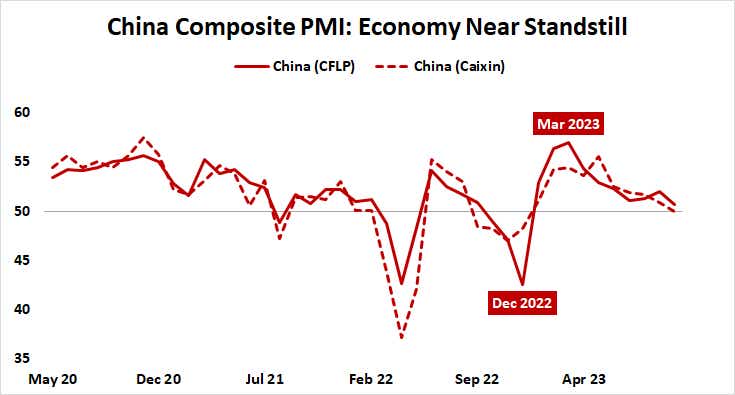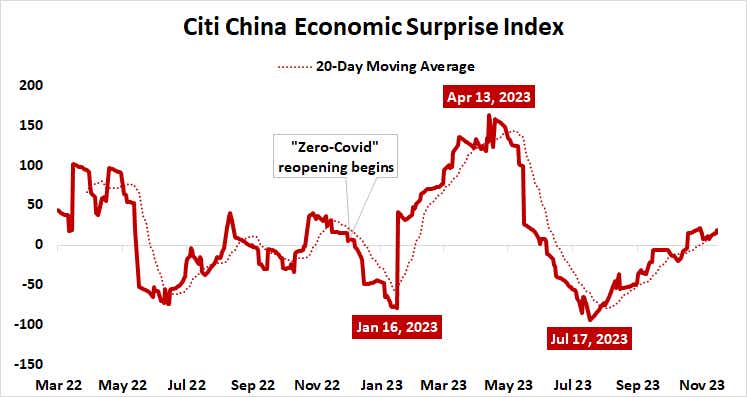Chinese Markets Climb as Bargain Hunters Look Past Economic Pain

Chinese Markets Climb as Bargain Hunters Look Past Economic Pain
By:Ilya Spivak
Chinese stocks are on pace for their best week in four months as investors’ outlook brightens despite thin economic growth. That’s because all of the “bad news” may be priced in for now.
- Chinese stocks are on pace for their best performance in four months.
- Investors’ outlook brightens even with China’s economy near standstill.
- Recovery to continue if the news flow isn’t worse than expected.
Chinese stocks are on the rebound. The iShares China Large Cap ETF (FXI)—which tracks the FTSE China A50 index of the largest names on the Shanghai and Shenzhen exchanges—is on pace to add nearly 6% this week. That would amount to the best performance in four months.
Some of the rise is surely attributable to swelling market-wide risk appetite following supportive U.S. consumer price index (CPI) data. Nevertheless, domestic news flow has not disappointed.
Figures published this week showed industrial production grew 4.6% year-on-year in October, topping the expected rise of 4.4%. Still more encouraging, retail sales added 7.6% over the same period, sailing past forecasts penciling in 7% and marking the biggest increase in five months.
China’s economy remains weak even as data flow improves
While certainly encouraging in relative terms, such outcomes mark incremental outperformance rather than surging demand. Leading surveys of purchasing managers (PMI) published two weeks ago—an official set from the authorities in Beijing and an analog private-sector one from Caixin and S&P Global—put economic activity near standstill.

Investors’ attitudes have brightened all the same. Foreign currency deposits increased for the first time in seven months in October. They still registered down 9.2% compared with the prior year, but that admittedly beefy number marked the smallest decline (and the first single-digit one) since August 2022.
Capital outflows pressuring the Chinese yuan have eased as well. The spread between the markets’ expected daily exchange rate to the U.S. dollar and the official one set by the People’s Bank of China (PBOC) has narrowed to the smallest since mid-August, erasing nearly three quarters of the historically wide disparity recorded in September.
Markets tied to China can recover as "bad news" runs dry
Analytics from Citigroup suggests Chinese data outcomes now skew toward surprising on the upside relative to expectations. This may indicate markets have already priced in the bulk of the bad news about the country’s disappointing performance following Beijing’s move to scrap “zero-COVID” lockdowns in December 2022.

Financial markets are inherently forward-looking. Movement in asset prices is generated as expectations are continuously tested against outcomes. Where there are discrepancies, asset values move as portfolios are repriced to reflect realized results and the updated outlook for what’s to come next.
That means that economic weakness by itself is not an inherent hurdle for risk appetite if conditions are not worse than the markets are anticipating. Results need not be “good,” just “tolerable” enough for investors to nibble on bargain-hunting opportunities. For China-anchored assets, this looks to be setting the stage for continued recovery.
Ilya Spivak, tastylive head of global macro, has 15 years of experience in trading strategy, and he specializes in identifying thematic moves in currencies, commodities, interest rates and equities. He hosts Macro Money and co-hosts Overtime, Monday-Thursday. @Ilyaspivak
For live daily programming, market news and commentary, visit tastylive or the YouTube channels tastylive (for options traders), and tastyliveTrending for stocks, futures, forex & macro.
Trade with a better broker, open a tastytrade account today. tastylive, Inc. and tastytrade, Inc. are separate but affiliated companies.
Options involve risk and are not suitable for all investors. Please read Characteristics and Risks of Standardized Options before deciding to invest in options.
tastylive content is created, produced, and provided solely by tastylive, Inc. (“tastylive”) and is for informational and educational purposes only. It is not, nor is it intended to be, trading or investment advice or a recommendation that any security, futures contract, digital asset, other product, transaction, or investment strategy is suitable for any person. Trading securities, futures products, and digital assets involve risk and may result in a loss greater than the original amount invested. tastylive, through its content, financial programming or otherwise, does not provide investment or financial advice or make investment recommendations. Investment information provided may not be appropriate for all investors and is provided without respect to individual investor financial sophistication, financial situation, investing time horizon or risk tolerance. tastylive is not in the business of transacting securities trades, nor does it direct client commodity accounts or give commodity trading advice tailored to any particular client’s situation or investment objectives. Supporting documentation for any claims (including claims made on behalf of options programs), comparisons, statistics, or other technical data, if applicable, will be supplied upon request. tastylive is not a licensed financial adviser, registered investment adviser, or a registered broker-dealer. Options, futures, and futures options are not suitable for all investors. Prior to trading securities, options, futures, or futures options, please read the applicable risk disclosures, including, but not limited to, the Characteristics and Risks of Standardized Options Disclosure and the Futures and Exchange-Traded Options Risk Disclosure found on tastytrade.com/disclosures.
tastytrade, Inc. ("tastytrade”) is a registered broker-dealer and member of FINRA, NFA, and SIPC. tastytrade was previously known as tastyworks, Inc. (“tastyworks”). tastytrade offers self-directed brokerage accounts to its customers. tastytrade does not give financial or trading advice, nor does it make investment recommendations. You alone are responsible for making your investment and trading decisions and for evaluating the merits and risks associated with the use of tastytrade’s systems, services or products. tastytrade is a wholly-owned subsidiary of tastylive, Inc.
tastytrade has entered into a Marketing Agreement with tastylive (“Marketing Agent”) whereby tastytrade pays compensation to Marketing Agent to recommend tastytrade’s brokerage services. The existence of this Marketing Agreement should not be deemed as an endorsement or recommendation of Marketing Agent by tastytrade. tastytrade and Marketing Agent are separate entities with their own products and services. tastylive is the parent company of tastytrade.
tastyfx, LLC (“tastyfx”) is a Commodity Futures Trading Commission (“CFTC”) registered Retail Foreign Exchange Dealer (RFED) and Introducing Broker (IB) and Forex Dealer Member (FDM) of the National Futures Association (“NFA”) (NFA ID 0509630). Leveraged trading in foreign currency or off-exchange products on margin carries significant risk and may not be suitable for all investors. We advise you to carefully consider whether trading is appropriate for you based on your personal circumstances as you may lose more than you invest.
tastycrypto is provided solely by tasty Software Solutions, LLC. tasty Software Solutions, LLC is a separate but affiliate company of tastylive, Inc. Neither tastylive nor any of its affiliates are responsible for the products or services provided by tasty Software Solutions, LLC. Cryptocurrency trading is not suitable for all investors due to the number of risks involved. The value of any cryptocurrency, including digital assets pegged to fiat currency, commodities, or any other asset, may go to zero.
© copyright 2013 - 2025 tastylive, Inc. All Rights Reserved. Applicable portions of the Terms of Use on tastylive.com apply. Reproduction, adaptation, distribution, public display, exhibition for profit, or storage in any electronic storage media in whole or in part is prohibited under penalty of law, provided that you may download tastylive’s podcasts as necessary to view for personal use. tastylive was previously known as tastytrade, Inc. tastylive is a trademark/servicemark owned by tastylive, Inc.